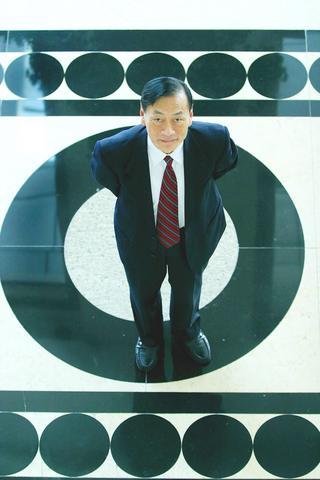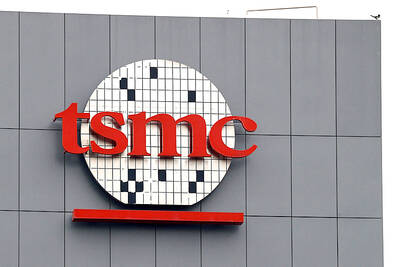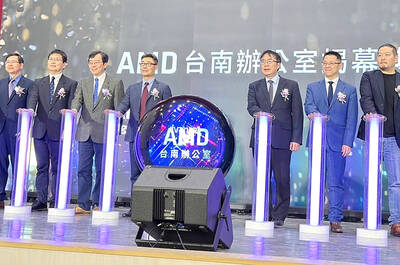Add Steve Chen to the growing list of US high-technology exports.
Chen, a Taiwanese-born US citizen who was considered one of the nation's most brilliant supercomputer designers while working in this country for the technology pioneer Seymour Cray in the 1980s, has moved to China, where he is leading an effort to claim the world computing speed record.

PHOTO: NY TIMES
The Chinese government is seizing upon supercomputing to help speed the nation's transition from low-cost manufacturing to becoming a more powerful force in the world economy. China's leaders know that high-speed computing is essential to global leadership in scientific fields and advanced design of a variety of sophisticated products.
"Right now the Chinese have started to pay attention; they are catching up, and they learn fast," said Chen, 60, who is splitting his time between China and San Jose, California, where his wife, Kate, and their four children live.
Military intelligence experts in this country have long been concerned that supercomputing capabilities may aid China's weapons development. But many technologists and economists say that blazing computing speeds alone do not represent a particularly new nuclear weapons threat.
Instead, they are more concerned that the Chinese may catch up more quickly with the US in areas that have economic and scientific ramifications.
INVESTMENT NEED
Chen's decision to set up shop in China was driven in part by an unexpected twist: The opportunity to build a new company looked more promising to him there than in the US, where he was unable to secure financing from US venture capitalists for his latest ideas.
Chen concluded that the fallout from the collapse of the Internet bubble had poisoned the investment climate.
"I saw the crazy stuff going on," he said recently in a telephone interview from Shenzhen. "A lot of people got hurt."
While Chen is not a native of China, his decision has parallels to an increasingly common odyssey by foreign-born researchers, who once would have found the greatest openings to use their skills in the US.
As the spread of capitalism creates opportunities elsewhere, many such talented people are returning to China, India and other developing countries to create or join advanced technology firms.
In May, Chen joined Galactic Computing Shenzhen, which is backed by investment money from a Hong Kong company that supported an earlier Chen venture and by a group of Chinese universities.
His move reflects the fact that the market for high-performance computing is growing more rapidly in China than elsewhere in the world.
The Chinese are not yet a major force in supercomputing, but according to US computing experts, that is changing rapidly.
Today there are 14 Chinese supercomputers among the top 500, ranking the country fourth in the world, equal to Germany and behind only the US, Japan and Britain.
In June, a supercomputer assembled at the Shanghai Supercomputer Center using more than 2,500 chips designed and manufactured by Advanced Micro Devices of Sunnyvale, California, became the world's 10th-fastest computer.
"In terms of momentum they are the most rapidly ascending country in the world," said David Keyes, a professor of applied mathematics at Columbia University, who visited China recently to participate in a conference on high-performance computing.
Galactic recently demonstrated a prototype of Chen's newest supercomputer at a biomedical research institute in Beijing. The machine, he said, is capable of 1 trillion calculations a second, a performance level that would place it among the top half of the world's 500 fastest computers.
US LOSING GROUND
Such computing now occupies a central role in the global economy, providing stark proof that decades-long US attempts to control the flow of advanced information-processing technologies are largely moot.
It is only a matter of time, experts say, before companies in countries like China, India and Russia essentially match the capabilities of the US and Japanese leaders.
"When they really get noticed," said Horst Simon, director of the computation center at the Law-rence Berkeley National Laboratory in California, "will be when a country like Malaysia or Australia decides to buy a supercomputer from a Chinese company like Mr. Chen's rather than from IBM."
Now that computer chips openly available anywhere in the world have reached such high speeds, the expertise needed to build supercomputers has shifted to the software needed to hook hundreds or thousands of processors together. Chen has long been recognized as one of the world's pioneers in that specialty.
Chen arrived in the US from Taiwan in 1975, at age 31, to pursue graduate studies in computer science. During the 1980s, Chen was widely considered one the leading computer designers in the US.
As a computer architect at Cray Research from 1979 to 1987, he gained a reputation for machines that were both elegant and blindingly fast. He also became known as a visionary who frequently needed assistance in finishing overambitious projects.
"He's very charismatic," said David Kuck, a computer scientist and Intel researcher, who was Chen's professor in a doctoral program at the University of Illinois at Urbana-Champaign in the 1970s.
"His English wasn't the great-est, but everyone understood what he wanted to do," Kuck said.
PIONEERING WORK
As a graduate student, Chen designed one of the first software programs known as a parallel com-piler, which was useful in restructuring programs so they could run on computers with multiple processors. That pioneering work became the basis for much of today's commercial parallel computing software.
At Cray Research, Chen had an intense rivalry with Cray, who was leading a team that pursued a competing design.
Ultimately, Cray's chief executive, John Roll-wagen, canceled one of Chen's computer projects.
Soon afterward, in September 1987, Chen established his own supercomputing company, Supercomputing Systems, with backing from IBM.
That effort led to a partially completed prototype, but the company failed commercially in 1992 when IBM canceled funding.
Because the Cold War was ending, military funding for high-performance computing slowed dra-matically. Later, Chen became the chief technology officer of Sequent Computer Systems, which was later acquired by IBM.
US supercomputer experts said Chen's move to China could have a major impact, similar to the shock felt among government technology insiders back in 2002 when Japan developed the Earth Simulator, which is currently the world's fastest supercomputer.
"There is no stronger form of technology transfer than to have a world-class expert go off with all his knowledge," said Seymour Goodman, a physicist at the Sam Nunn School of International Affairs at the Georgia Institute of Technology in Atlanta.
LONG-TERM GOALS
Chen was an eager convert to American ways after he moved to the US from Taiwan -- even bringing members of his extended family to Eau Claire, Wisonsin, where he established a stylish Chinese restaurant.
Chen said he still viewed himself primarily as a scientist dedicated to contributing to supercomputer design in ways that would benefit not just China but the US and the rest of the world, too. He said he intended to pursue that goal with whoever offered him the greatest help.
That reflects long-held views, which he expressed in an interview with The New York Times in the early 1990s.
"I come from a very humble family, and Confucian teachings are in my background," he said then. "When I came to the United States and I observed this disciplined, businesslike, practical manner, I found a marriage of the two cultures. I also saw the bad points of each."

Anna Bhobho, a 31-year-old housewife from rural Zimbabwe, was once a silent observer in her home, excluded from financial and family decisionmaking in the deeply patriarchal society. Today, she is a driver of change in her village, thanks to an electric tricycle she owns. In many parts of rural sub-Saharan Africa, women have long been excluded from mainstream economic activities such as operating public transportation. However, three-wheelers powered by green energy are reversing that trend, offering financial opportunities and a newfound sense of importance. “My husband now looks up to me to take care of a large chunk of expenses,

SECTOR LEADER: TSMC can increase capacity by as much as 20 percent or more in the advanced node part of the foundry market by 2030, an analyst said Taiwan Semiconductor Manufacturing Co (TSMC, 台積電) is expected to lead its peers in the advanced 2-nanometer process technology, despite competition from Samsung Electronics Co and Intel Corp, TrendForce Corp analyst Joanne Chiao (喬安) said. TSMC’s sophisticated products and its large production scale are expected to allow the company to continue dominating the global 2-nanometer process market this year, Chiao said. The world’s largest contract chipmaker is scheduled to begin mass production of chips made on the 2-nanometer process in its Hsinchu fab in the second half of this year. It would also hold a ceremony on Monday next week to

TECH CLUSTER: The US company’s new office is in the Shalun Smart Green Energy Science City, a new AI industry base and cybersecurity hub in southern Taiwan US chip designer Advanced Micro Devices Inc (AMD) yesterday launched an office in Tainan’s Gueiren District (歸仁), marking a significant milestone in the development of southern Taiwan’s artificial intelligence (AI) industry, the Tainan City Government said in a statement. AMD Taiwan general manager Vincent Chern (陳民皓) presided over the opening ceremony for the company’s new office at the Shalun Smart Green Energy Science City (沙崙智慧綠能科學城), a new AI industry base and cybersecurity hub in southern Taiwan. Facilities in the new office include an information processing center, and a research and development (R&D) center, the Tainan Economic Development Bureau said. The Ministry

ADVERSARIES: The new list includes 11 entities in China and one in Taiwan, which is a local branch of Chinese cloud computing firm Inspur Group The US added dozens of entities to a trade blacklist on Tuesday, the US Department of Commerce said, in part to disrupt Beijing’s artificial intelligence (AI) and advanced computing capabilities. The action affects 80 entities from countries including China, the United Arab Emirates and Iran, with the commerce department citing their “activities contrary to US national security and foreign policy.” Those added to the “entity list” are restricted from obtaining US items and technologies without government authorization. “We will not allow adversaries to exploit American technology to bolster their own militaries and threaten American lives,” US Secretary of Commerce Howard Lutnick said. The entities